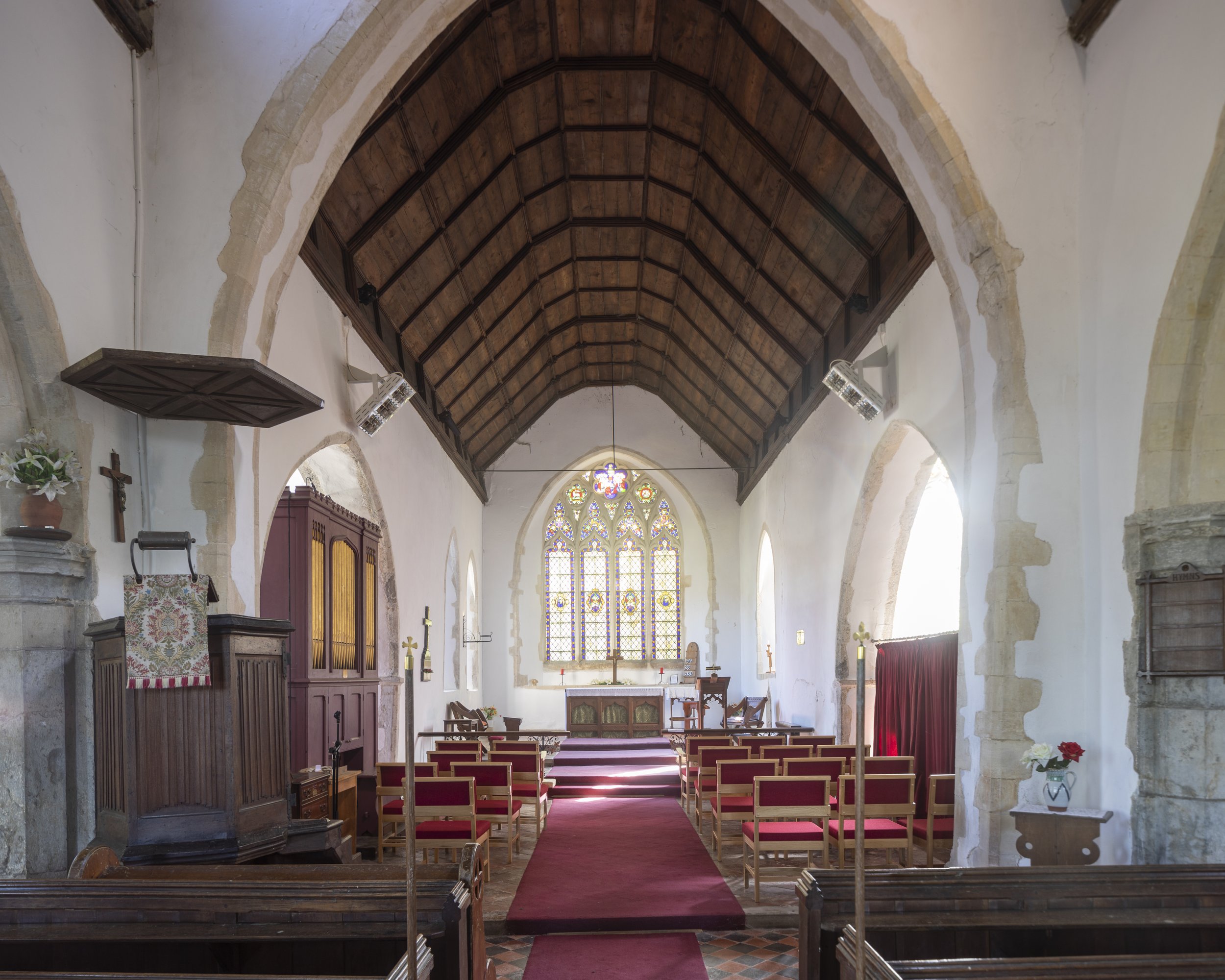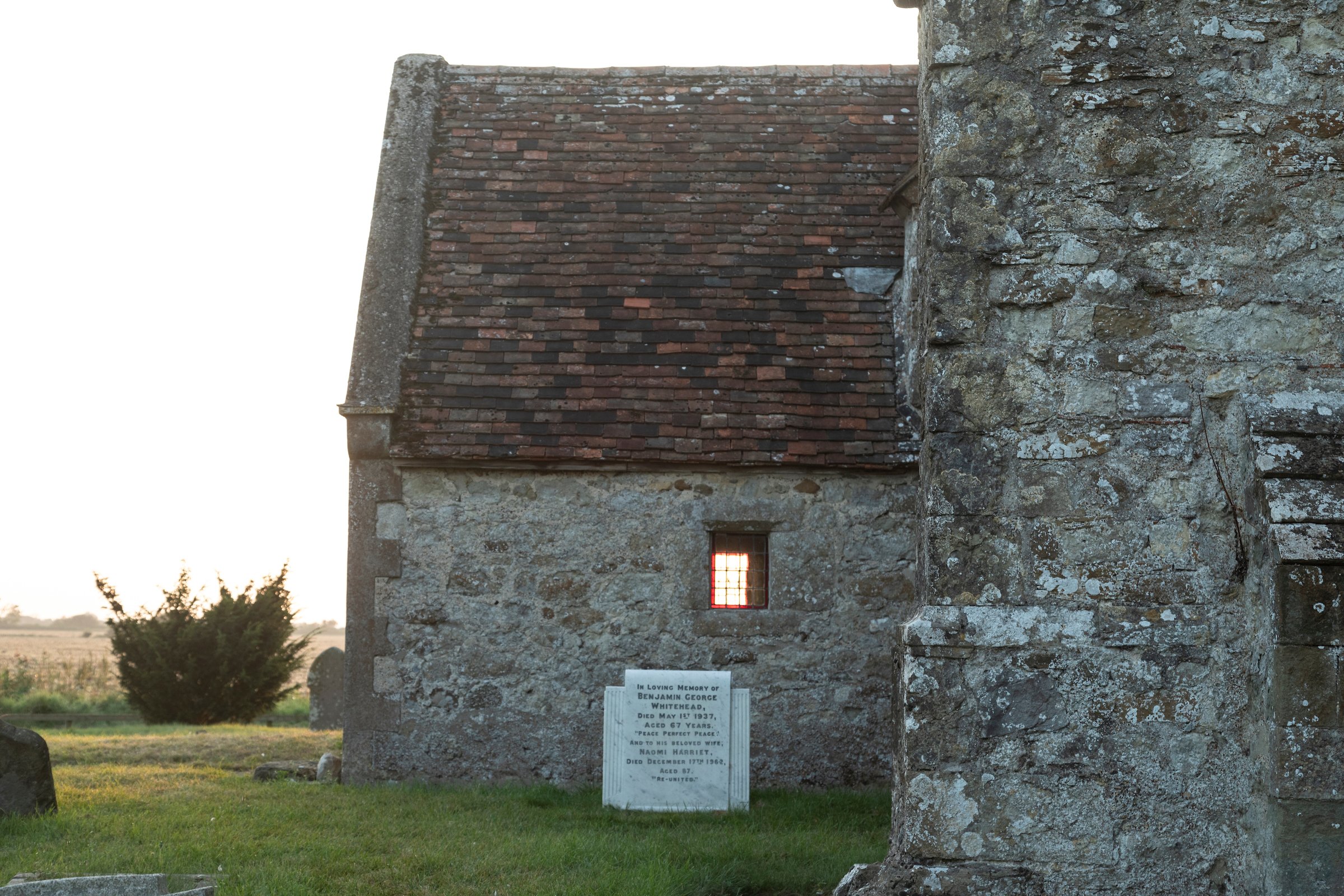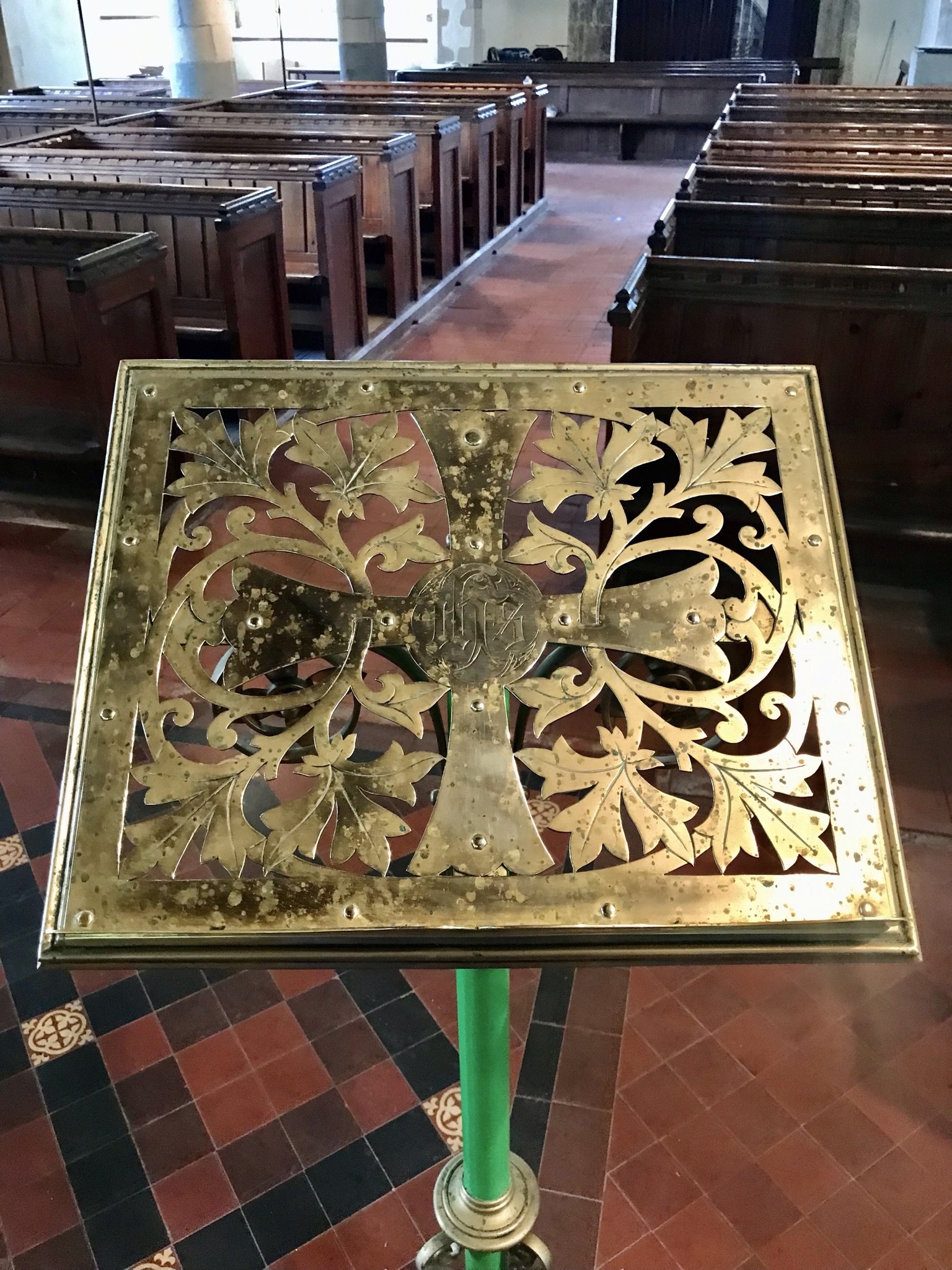
Church Features
SOME INTERESTING THINGS TO LOOK FOR WHEN VISITING A HISTORIC CHURCH
On this page we have listed some interesting things to look out for when visiting historic churches. This short guide can be particularly useful for people who are less familiar with churches and/or church history.
Below are some features which are common to many, if not all, of the marsh churches.
For a more in-depth look, our audio guide and virtual tours highlight the unique features and history of each marsh church.
What to look for inside a church
The altar and reredos
The altar is the most sacred part of the church. It can be found in the sanctuary, an area that normally has a rail around it, usually on the east side of the church. The area behind the altar may have an ornamental screen covering, called a reredos, like this one at Burmarsh.
Fonts and font covers
The font is usually found near the church door. Fonts are used to hold water for baptisms. In 1236 the Archbishop of Canterbury ordered that fonts should be covered and locked to prevent people from stealing holy water. This 15th century font at Newchurch bears the emblems of St. Peter and St. Paul, as well as the roses of York, Lancaster and the Tudor Rose.
Pulpits
The pulpit is a raised platform used to deliver the sermon. Some pulpits have canopies or sounding boards above them, to amplify the speaker’s voice. Triple-decker pulpits were introduced in the 17th and 18th centuries - the preacher would sit in the top part, the reader the next and the clerk in the lower part. This mahogany triple-decker pulpit at Fairfield is one of the few surviving examples of this variety, and the only such example on the marsh.
Stained Glass
Stained glass adds colour and beauty to churches. The windows often show scenes from the Bible. They helped to teach people in the days when few people could read. The colours may also have had special meaning - red for divine love, white for divine wisdom and yellow for divine faith. Many stained glass windows were replaced during the Reformation. This window is at New Romney.
Screens (or the absence of!)
Screens were used to separate the Chancel from the Nave. They may also enclose tombs or chapels. Wooden screens are often ornately carved, such as this one at Newchurch. Prior to the Reformation, above the chancel screen (called a rood screen) would have been a beam (the rood beam) and a platform (the rood loft) - on this platform would have stood a carving of Christ on the cross, along with candles and figures of St. Mary and St. John. Most of these screens and platforms were destroyed during the Reformation. In some marsh churches you can see where the entrance to the rood loft would have once been (e.g. at St. Mary in the Marsh and Snargate).
The organ (and perhaps a minstrels’ gallery)
Church organs contain hundreds of pipes of different sizes. Often they are richly decorated. Before organs were installed, local minstrels may have performed from a gallery, usually at the west end of the church. Only two marsh churches still have galleries - Dymchurch (seen here) and Old Romney (which is painted pink!).
Pews, benches and chairs
Before churches had seats, people stood, or sat on woven reed mats on the floor. Low stone seats were attached to the walls for old and sick people - hence the phrase “let the weakest go to the wall". Around the 15th century, tall box pews were used to keep the wealthiest people warm, while some sections of society had special benches for their families. Sometimes bench ends were ornately carved. Carvings at Newchurch show winged bishops holding the keys of St. Peter and the sword of St. Paul.
Lecterns
The lectern is used to hold the Bible. It is usually made of wood or brass, such as this example at Snargate, which bears the initials I.H.S., standing for Iesus Hominum Salvator or Jesus, the saviour of mankind.
Sedilia
Sedilia are canopied seats built into the walls of some churches. Usually the seats are different heights - the highest, nearest the altar, is for the priest, and others for the deacons. This example is from Snave.
Piscina
Piscinae were shallow stone basins used to wash the sacred vessels of mass (the chalice and plate). The basin drains onto the holy consecrated ground of the churchyard. This rare double example is from St Mary in the Marsh.
Chests
Historically, chests were often used for keeping the parish registers, including records of births and deaths. Often several people had to be present before a chest could be opened. Some large chests were also used for the purpose of collecting alms. Chests are often ornately carved, such as this one at Old Romney.
Murals
Prior to the Reformation, most church interiors were richly decorated, often depicting scenes from the Bible and the lives of Saints. Paintings helped teach parishioners in the days before most people could read. Many church interiors were painted white during the Reformation. This mural at Brookland depicts the murder of local Saint, Thomas Becket, in Canterbury Cathedral - it was discovered during repairs to the south wall in 1964.
Carved Effigies
The earliest tombs inside churches are usually simple stone slabs with a grave beneath. From the 13th century, effigies became more common - a carved top of the slab, depicting an image of the deceased. This tomb at Lydd is believed to show a crusader, Sir Walter de Menyl.
Brasses
Brasses are thin pieces of metal set into the stone floor. Introduced in the 13th century, they act as memorials to people who have passed away. Many brasses are in memory of wealthy local estate owners or other patrons of the church. This one can be found at St Mary in the Marsh.
The Stoup
The stoup is a small basin, often just inside or outside the main church door. It was used to hold blessed holy water. Worshippers entering the church would dip a finger in the water and make the sign of the cross on their foreheads, to remind them of their baptism and cleanse their sins. This example is found at Newchurch.
Easter Sepulchre
This is a recess usually found in the north wall of the Chancel. On Good Friday, consecrated bread (the host) and a crucifix or cross would be placed here and watched until Easter morning. They were then carried to the altar to remind people of Christ’s death, burial and resurrection. This example is found at New Romney, where a famous Easter Passion Play was held in medieval times.
Graffiti
Look closely and you might notice symbols scratched or burned into the walls, pillars and beams. Some marks were made by pilgrims who stopped at the churches on long journeys. Others were made by parishioners or clergy. Some symbols have special meanings, while others are a mystery. It’s possible that some marks were associated with superstitions and rituals to protect from evil. The examples shown here are from Ivychurch.
Bells
Bells called people to worship and were sometimes used to mark the hours of the day. In medieval times, the evening curfew bell reminded people to put out fires - the word curfew is from the Old French phrase "couvre-feu", which means "cover fire". William the Conqueror introduced a law that all lights and fires should be covered at night, to prevent spread between timber buildings. The bell pictured here sits inside Brookland’s distinctive octagonal wooden belfry.
What to look for outside a church
The site/location
Churches were often built on hills for visibility, but on the flat Romney Marsh this was not possible. Several marsh churches were built on naturally-occurring or artificial mounds, to raise them above winter flood levels. When the churches were first built, the landscape here looked very different - the sea flowed up channels and inlets into the centre of the marsh. Several churches were actually built on islands but the land around them has since been drained. The small church at Fairfield, shown here, used to be accessible only by boat or on horseback during winter floods. It was probably first built as a temporary structure to serve the farming communities around this small hamlet.
The size and stone
Most of the marsh churches were probably built on the sites of earlier wooden Saxon churches, as most are mentioned in the Domesday book of 1086. Lydd has the oldest masonry on the marsh - part of an Anglo-Roman basilica is built into the walls. Most of the churches are built of local Kentish ragstone, which still would have been brought from some distance. Several churches also contain Caen stone features - this was brought from France by the Normans and was easier to carve. Most of the marsh villages have always been small but some of the churches are huge - their size and lavishness symbolised the great wealth and power of their patrons and landowners. St George’s at Ivychurch, shown here, was financially supported by the Archbishops of Canterbury and built on their land in the manor of Aldington.
The Churchyard
The churchyard surrounding the building has been consecrated (meaning ‘set apart as sacred’). In medieval times, land on the north of the churchyard was not consecrated - land here was used for games, but also for burials of criminals, outcasts and unbaptised babies, who would lie in everlasting shadow. Today many marsh churchyards are havens for wildlife - largely unchanged for hundreds of years, some even have rare species. Dymchurch is shown here.
Spires and Towers
At the West End of most churches is a tower and/or spire. Towers were useful waymarkers and lookout posts, and may have even been used by archers. The tall towers of Lydd and New Romney would have helped guide ships into port. Towers are very heavy structures - the one at Brookland stands separately to the church and is made of wood, to stop it sinking in the boggy ground. The stone tower at Newchurch began to lean alarming when it was first built! The spire rises above the tower, up towards the heavens. Before clocks were added, people relied on church bells to tell the time. The tower at St Mary in the Marsh, shown here, was repaired with the support of the Romney Marsh Historic Churches Trust.
Porches
Porches are usually found on the south side of the church. In medieval times porches were important - marriages were held there and the baptism service began there. Legal agreements were made there and sinners were forgiven there before entering the church. Stone seats in the porch often indicate it was used as a school. Some churches have a room above the porch, like this one at Ivychurch - this was a place for visiting priests to sleep (the parvis chamber). During World War II the parvis chamber at Ivychurch stored emergency food rations while the Home Guard kept a nightly vigil atop the tower.
Doors and hinges
Old church doors are usually very strong, as the church was a place of refuge. In medieval times, the door on the north of a church was opened during a baptism service to allow evil spirits believed to be in the child to escape. Norman doorways are round-headed and often deeply recessed, with ornate carvings - often zig-zags. The doorway at New Romney now sits several feet below ground level, as the land surrounding the church was raised during the Great Storms of the 1200s. Medieval doors had beautiful iron hinges, locks and latches. Some would have once had knockers - used by those seeking sanctuary in the church.
Weather Vanes
At the top of the spire may be a weather vane - a device for showing which way the wind is blowing. The design may be a cockerel or other animal, a compass, flag, coat of arms, figure or other symbolic shape. Fishing and sea trade were very important on Romney Marsh, so it was important to know the wind direction. The weather vane at St Mary in the Marsh was regilded with the support of the Romney Marsh Historic Churches Trust.
Gargoyles and Corbels
A gargoyle is a water spout that channels water away from the walls or roof. Sometimes they are carved as grotesque animals, birds and people - often representing vices or sins. They warned parishioners to leave evil thoughts outside the church.
Corbels are stones that support beams, arches or some other weight. They too are often carved in the shape of faces or figures.
With binoculars or a long photo lens you can see interesting carved heads at the very top of the spire at New Romney, shown here. There is even a carved pig!
Buttresses
Buttresses project from the outside walls, to give them extra strength. They were particularly important on the marsh, given the harsh weather conditions and boggy ground. Most marsh churches have had additional buttresses added at different points in history, as the weight of the roof and tower can push the walls outwards. The enormous buttresses at East Guldeford are made of brick, giving a distinctive character.
Parapets
Parapets are low walls at the edge of the roof. They may have different carvings or designs, such as these castle-like battlements at Burmarsh.
Niches
Some churches have niches with carved figures. These may show Saints or other figures from the Bible, such as this one over the main door at Brenzett.
Gravestones and Headstones
Family histories can be traced through gravestones and headstones. Many marsh graveyards show common local surnames spanning multiple generations. They may include interesting designs, symbols and crests such as this one at Dymchurch. Headstones, gravestones and wall tablets are memorials to the departed. Some table tombs are enormous, reflecting the wealth and status of the deceased. Several large tomb-chests at Brookland were restored with the support of the Romney Marsh Historic Churches Trust.
Scratch Dials
Sundials are old instruments used for measuring the time. The scratch dial, or mass dial, is an early form of sundial carved into the outside wall of a church - a rod was placed in the central hole, to cast a shadow. These carvings were used to note the time of the next service and when to ring the bells. The one shown here is found at Dymchurch - the original dial was shaded when the porch was added, so a new dial was added at the south-east corner.
Trees
Trees in churchyards are often very old. They may sometimes be older than the church itself. Many marsh churches were built where earlier wooden Saxon churches stood, which themselves were built on important pre-Christian sites. A yew tree can often found “guarding” the church. As it lives a very long time, it is a symbol of immortality (though the leaves and berries are highly poisonous!). The thick foliage of the yew tree acts as a wind-break and helps provide shelter, protecting the church. Long bows were traditionally made from yew wood. Its branches were also used to represent palms in Palm Sunday processions (sometimes known as Yew Sunday in medieval times). There is a huge yew tree at Old Romney which can be seen for miles.
Find out more with our virtuals tours and audio guides, which delve into the history, features and folklore of each marsh church.

































